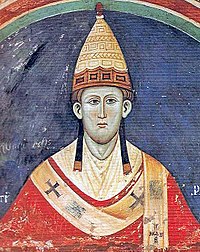SF,
Glad to have been of assistance

Was that the only question?
The latinate mitre reportedly only came into regular use about the 10th century and probably was originally reserved to the popes; the gift of it, accompanied by the implicit right to its use, was likely considered a signal honor.
The Armenians entered into some degree of union with Rome about 1180 or so (it lasted, off and on, for about 300 years, IIRC). Sources vary as to by which Pope (and, accordingly, when) the latinate mitre was gifted to the Catholicos. The Armenian Apostolic Church itself (as well as other authority) credits Pope Lucius III as gifting it. together with a crosier and patriarchal vestments, to Catholicos Grigor IV Tigha in 1184.
That makes sense to me, as a gesture of acknowledging and cementing the relationship. (Other sources cite Pope Innocent III, but there was no compelling event for him to have done so.)
The mitre and latinate crosier were both adopted and continue in use by hierarchs of both the Apostolic and Catholic Churches to this day. The prior usage had been similar to that of Byzantium (from which the Armenian liturgical usage, etc had originated, before their theological separation and geographic isolation resulted in development of their unique ritual praxis).
Subsequently, the Byzantine style headgear (see the example linked in my earlier post) and staff, abandoned by the bishops, devolved to the use of the two uppermost ranks of Vartabads, prelature dignities akin to those of Mitred Archpriests and Archimandrites in Churches of Byzantine origin and of Chorepiscopi and Periodeuts in those of Antiochene origin.
Many years,
Neil

